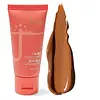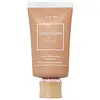What's inside
What's inside
 Key Ingredients
Key Ingredients

 Benefits
Benefits

 Concerns
Concerns

 Ingredients Side-by-side
Ingredients Side-by-side

Water
Skin ConditioningDimethicone
EmollientIsododecane
EmollientMethyl Trimethicone
Skin ConditioningButylene Glycol
HumectantPEG-9 Polydimethylsiloxyethyl Dimethicone
EmulsifyingPEG-10 Dimethicone
Skin ConditioningVinyl Dimethicone/Methicone Silsesquioxane Crosspolymer
Disteardimonium Hectorite
StabilisingNylon-12
Trimethylsiloxysilicate
EmollientSodium Chloride
MaskingDimethicone/PEG-10/15 Crosspolymer
Triethyl Citrate
MaskingDimethicone/Phenyl Vinyl Dimethicone Crosspolymer
Methicone
EmollientPolysilicone-11
Diglycerin
HumectantTalc
AbrasiveDipropylene Glycol
HumectantMalus Domestica Fruit Cell Culture Extract
Skin ConditioningSodium Citrate
BufferingEnantia Chlorantha Bark Extract
Skin ConditioningXanthan Gum
EmulsifyingTocopherol
AntioxidantMaltodextrin
AbsorbentOrthosiphon Stamineus Extract
Skin ConditioningGlycerin
HumectantLecithin
EmollientOleanolic Acid
Skin ConditioningSodium Dehydroacetate
PreservativePotassium Sorbate
PreservativePhenoxyethanol
PreservativeIron Oxides
Titanium Dioxide
Cosmetic ColorantMica
Cosmetic ColorantWater, Dimethicone, Isododecane, Methyl Trimethicone, Butylene Glycol, PEG-9 Polydimethylsiloxyethyl Dimethicone, PEG-10 Dimethicone, Vinyl Dimethicone/Methicone Silsesquioxane Crosspolymer, Disteardimonium Hectorite, Nylon-12, Trimethylsiloxysilicate, Sodium Chloride, Dimethicone/PEG-10/15 Crosspolymer, Triethyl Citrate, Dimethicone/Phenyl Vinyl Dimethicone Crosspolymer, Methicone, Polysilicone-11, Diglycerin, Talc, Dipropylene Glycol, Malus Domestica Fruit Cell Culture Extract, Sodium Citrate, Enantia Chlorantha Bark Extract, Xanthan Gum, Tocopherol, Maltodextrin, Orthosiphon Stamineus Extract, Glycerin, Lecithin, Oleanolic Acid, Sodium Dehydroacetate, Potassium Sorbate, Phenoxyethanol, Iron Oxides, Titanium Dioxide, Mica
Cyclopentasiloxane
EmollientWater
Skin ConditioningIsododecane
EmollientButylene Glycol
HumectantDimethicone
EmollientPolymethyl Methacrylate
Polysilicone-11
PEG-9 Polydimethylsiloxyethyl Dimethicone
EmulsifyingTrimethylsiloxysilicate
EmollientDimethicone/PEG-10/15 Crosspolymer
Phenoxyethanol
PreservativeMagnesium Sulfate
Hdi/Trimethylol Hexyllactone Crosspolymer
Aluminum Hydroxide
EmollientSodium Citrate
BufferingParfum
MaskingTocopheryl Acetate
AntioxidantC24-28 Alkyl Methicone
EmollientTriethoxycaprylylsilane
Ethylhexylglycerin
Skin ConditioningKaolin
AbrasiveDipropylene Glycol
HumectantSilica
AbrasiveBenzyl Salicylate
PerfumingHexyl Cinnamal
PerfumingLimonene
PerfumingHydroxycitronellal
PerfumingGeraniol
PerfumingTocopherol
AntioxidantAmyl Cinnamal
PerfumingLinalool
PerfumingTitanium Dioxide
Cosmetic ColorantIron Oxides
Cyclopentasiloxane, Water, Isododecane, Butylene Glycol, Dimethicone, Polymethyl Methacrylate, Polysilicone-11, PEG-9 Polydimethylsiloxyethyl Dimethicone, Trimethylsiloxysilicate, Dimethicone/PEG-10/15 Crosspolymer, Phenoxyethanol, Magnesium Sulfate, Hdi/Trimethylol Hexyllactone Crosspolymer, Aluminum Hydroxide, Sodium Citrate, Parfum, Tocopheryl Acetate, C24-28 Alkyl Methicone, Triethoxycaprylylsilane, Ethylhexylglycerin, Kaolin, Dipropylene Glycol, Silica, Benzyl Salicylate, Hexyl Cinnamal, Limonene, Hydroxycitronellal, Geraniol, Tocopherol, Amyl Cinnamal, Linalool, Titanium Dioxide, Iron Oxides
Ingredients Explained
These ingredients are found in both products.
Ingredients higher up in an ingredient list are typically present in a larger amount.
Butylene Glycol (or BG) is used within cosmetic products for a few different reasons:
Overall, Butylene Glycol is a safe and well-rounded ingredient that works well with other ingredients.
Though this ingredient works well with most skin types, some people with sensitive skin may experience a reaction such as allergic rashes, closed comedones, or itchiness.
Learn more about Butylene GlycolDimethicone is a type of synthetic silicone created from natural materials such as quartz.
What it does:
Dimethicone comes in different viscosities:
Depending on the viscosity, dimethicone has different properties.
Ingredients lists don't always show which type is used, so we recommend reaching out to the brand if you have questions about the viscosity.
This ingredient is unlikely to cause irritation because it does not get absorbed into skin. However, people with silicone allergies should be careful about using this ingredient.
Note: Dimethicone may contribute to pilling. This is because it is not oil or water soluble, so pilling may occur when layered with products. When mixed with heavy oils in a formula, the outcome is also quite greasy.
Learn more about DimethiconeDimethicone/PEG-10/15 Crosspolymer is a type of silicone.
Dipropylene Glycol is a synthetically created humectant, stabilizer, and solvent.
This ingredient helps:
Dipropylene glycol is technically an alcohol, but it belongs to the glycol family (often considered part of the ‘good’ alcohols). This means it is hydrating and gentle on skin unlike drying solvent alcohols like denatured alcohol.
As a masking agent, Dipropylene Glycol can be used to cover the smell of other ingredients. However, it does not have a scent.
Studies show Dipropylene Glycol is considered safe to use in skincare.
Learn more about Dipropylene GlycolIsododecane is a fragrance, emollient, and solvent.
As an emollient, it helps your skin stay soft and hydrated. Emollients help trap moisture into your skin.
Isododecane's role as a solvent makes it a great texture enhancer. It spreads smoothly on skin and does not leave a sticky feeling behind. Isododecane also helps prevent color transfer in makeup products.
Isododecane is not absorbed into skin.
Learn more about IsododecanePEG-9 Polydimethylsiloxyethyl Dimethicone is a type of silicone.
Phenoxyethanol is a preservative that has germicide, antimicrobial, and aromatic properties. Studies show that phenoxyethanol can prevent microbial growth. By itself, it has a scent that is similar to that of a rose.
It's often used in formulations along with Caprylyl Glycol to preserve the shelf life of products.
Polysilicone-11 is a film-forming silicone that creates a non-tacky and matte finish on the skin. It's commonly used to improve texture, absorb excess oil, and help active ingredients spread evenly.
Due to its "rubber-like" structure, it stays on the skin's surface instead of being absorbed. On the skin, it creates a flexible layer that enhances wearability and stability.
Sodium Citrate is the sodium salts of citric acid. In skincare, it is used to alter pH levels and acts as a preservative.
Its main functions are to maintain the pH of a product and neutralize metal ions.
The acidity of our skin is maintained by our glands and skin biome; normal pH level of skin is slightly acidic (~4.75-5.5).
Being slightly acidic allows our skin to create an "acid mantle". This acid mantle is a thin barrier that protects our skin from bacteria and contaminants.
Learn more about Sodium CitrateTitanium dioxide is a mineral UV filter widely used in sunscreens and cosmetics.
It is one of only two UV filters officially classified as “mineral” by regulatory agencies, the other being zinc oxide.
Titanium dioxide provides broad-spectrum protection mostly in the UVB and UVAII range, with some protection in the UVAI range.
While its UVA protection isn’t as strong as zinc oxide’s, the difference is minor.
A common myth is that mineral UV filters reflect UV light. However, modern research shows titanium dioxide absorbs UV radiation like chemical filters (~95% absorption & 5% reflection).
Thanks to its non-irritating nature, titanium dioxide is suitable for sensitive, acne-prone, or redness-prone skin. It is unlikely to cause "eye sting" like other sunscreen ingredients.
A major drawback of this ingredient is its white cast and thick texture. This is why mineral sunscreens often leave a white cast and are less cosmetically elegant than chemical/hybrid sunscreens.
To improve white cast and spreadability, micronized or nano-sized titanium dioxide is often used.
There are ongoing concerns surrounding nano-titanium oxide's impact on marine ecosystems.
There is no conclusive evidence that any form of titanium oxide (or any other sunscreen ingredients) will cause harm to marine ecosystems or coral reefs. The science is still developing but many consumers are keeping a close eye on this issue.
Please note, many destinations have reef-safety sunscreen rules. For instance, the U.S. Virgin Islands advises all visitors to use non-nano mineral sunscreens.
Nano mineral sunscreens once raised safety concerns about absorption into skin.
Extensive research has shown that they do not penetrate healthy or damaged skin; they remain safely on the surface and the top layer of dead skin (stratum corneum).
You'll likely find titanium dioxide bundled with alumina, silica, or dimethicone. These ingredients help make titanium dioxide highly photostable; this prevents it from interacting with other formula components under UV light.
Learn more about Titanium DioxideTocopherol (also known as Vitamin E) is a common antioxidant used to help protect the skin from free-radicals and strengthen the skin barrier. It's also fat soluble - this means our skin is great at absorbing it.
Vitamin E also helps keep your natural skin lipids healthy. Your lipid skin barrier naturally consists of lipids, ceramides, and fatty acids. Vitamin E offers extra protection for your skin’s lipid barrier, keeping your skin healthy and nourished.
Another benefit is a bit of UV protection. Vitamin E helps reduce the damage caused by UVB rays. (It should not replace your sunscreen). Combining it with Vitamin C can decrease sunburned cells and hyperpigmentation after UV exposure.
You might have noticed Vitamin E + C often paired together. This is because it is great at stabilizing Vitamin C. Using the two together helps increase the effectiveness of both ingredients.
There are often claims that Vitamin E can reduce/prevent scarring, but these claims haven't been confirmed by scientific research.
Learn more about TocopherolThis silicone is an emollient. Emollients create a thin film on the skin to prevent moisture from escaping.
It is not soluble in water and helps increase water-resistance in products.
According to a manufacturer, it can blend seamlessly with silicone oils, such as Cyclopentasiloxane.
Learn more about TrimethylsiloxysilicateWater. It's the most common cosmetic ingredient of all. You'll usually see it at the top of ingredient lists, meaning that it makes up the largest part of the product.
So why is it so popular? Water most often acts as a solvent - this means that it helps dissolve other ingredients into the formulation.
You'll also recognize water as that liquid we all need to stay alive. If you see this, drink a glass of water. Stay hydrated!
Learn more about WaterThis ingredient is a combination of red, black, and yellow iron oxide pigments. This combination of colors is usually found in foundation, because it results in a "skin" color.